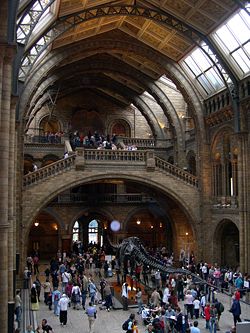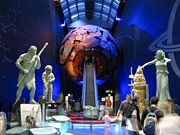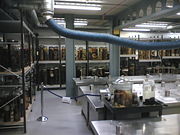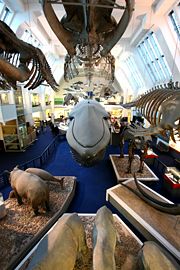Natural History Museum
| Natural History Museum | |
|---|---|
 |
|
| Established | 1881 |
| Location | Exhibition Road, South Kensington, London, England |
| Visitor figures | 3,600,119 (2006) [1] |
| Nearest tube station(s) | South Kensington |
| Website | www.nhm.ac.uk |
The Natural History Museum is one of three large museums on Exhibition Road, South Kensington, London (the others are the Science Museum, and the Victoria and Albert Museum). Its main frontage is on Cromwell Road. The museum is a Non-Departmental Public Body sponsored by the Department for Culture, Media and Sport
The museum is home to life and earth science specimens comprising some 70 million items within five main collections: Botany, Entomology, Mineralogy, Palaeontology and Zoology. The museum is a world-renowned centre of research, specialising in taxonomy, identification and conservation. Given the age of the institution, many of the collections have great historical as well as scientific value, such as specimens collected by Darwin.
The museum is particularly famous for its exhibition of dinosaur skeletons, and ornate architecture — sometimes dubbed a cathedral of nature — both exemplified by the large Diplodocus cast which dominates the vaulted central hall.
Originating from collections within the British Museum, the landmark Alfred Waterhouse building was built and opened by 1881, and later incorporated the Geological Museum. The Darwin Centre is a more recent addition, partly designed as a modern facility for storing the valuable collections.
|

History and architecture

The foundation of the collection was that of the Ulster doctor Sir Hans Sloane (1660–1753), who allowed his significant collections to be purchased by the British Government at a price well below their market value at the time. This purchase was funded by a lottery. Sloane's collection, which included dried plants, and animal and human skeletons, was initially housed in Montague House in Bloomsbury in 1756, which was the home of the British Museum.
Most of the Sloane collection had disappeared by the early decades of the nineteenth century. Sir George Shaw (Keeper of Zoology 1906-13) sold many specimens to the Royal College of Surgeons. His successor William Elford Leach made periodical bonfires in the grounds of the museum.[2] In 1833 the Annual Report states that, of the 5,500 insects listed in the Sloane catalogue, none remained. The inability of the natural history departments to conserve its specimens became notorious: the Treasury refused to entrust it with specimens collected at the government's expense. Appointments of staff were bedevilled by gentlemanly favoritism; in 1862 a nephew of the mistress of a Trustee was appointed Entomological Assistant who did not know the difference between a butterfly and a moth. [3][4]
J.E. Gray (Keeper of Zoology 1840-74) complained of the incidence of mental illness amongst staff: George Shaw threatened to put his foot on any shell not in the 12th edition of Linnaeus' Systema Naturae; another had removed all the labels and registration numbers from entomological cases arranged by a rival. The huge collection of conchologist Hugh Cuming was acquired by the museum, and Gray's own wife had carried the open trays across the courtyard in a gale: all the labels blew away. That collection is said never to have recovered. [5]
The Principal Librarian at the time was Antonio Panizzi; his contempt for the natural history departments and for science in general was total. The general public was not encouraged to visit the Museum's natural history exhibits. In 1835 to a Select Committee of Parliament, Sir Henry Ellis said this policy was fully approved by the Principal Librarian and his senior colleagues.
Many of these faults were corrected by Richard Owen, appointed Superintendent of the natural history departments of the British Museum in 1856. With some justification, Bill Bryson wrote "by making the Natural History Museum an institution for everyone, Owen transformed our expectations of what museums are for".[6]
Owen saw that the natural history departments needed more space, and that implied a separate building as the British Museum site was limited. Land in South Kensington was purchased, and in 1864 a competition was held to design the new museum. The winning entry was submitted by Captain Francis Fowke who died shortly afterwards. The scheme was taken over by Alfred Waterhouse who substantially revised the agreed plans, and designed the façades in his own idiosyncratic Romanesque style. The original plans included wings on either side of the main building, but these plans were soon abandoned for budgetary reasons. The space these would have occupied are now taken by the Earth Galleries and Darwin Centre.
Work began in 1873 and was completed in 1880. The new museum opened in 1881, although the move from the old museum was not fully completed until 1883.
Both the interiors and exteriors of the Waterhouse building make extensive use of terracotta tiles to resist the sooty climate of Victorian London, manufactured by the Tamworth-based company of Gibbs and Canning Limited. The tiles and bricks feature many relief sculptures of flora and fauna, with living and extinct species featured within the west and east wings respectively. This explicit separation was at the request of Owen, and has been seen as a statement of his contemporary rebuttal of Darwin's attempt to link present species with past through the theory of natural selection [1].
The central axis of the museum is aligned with the tower of Imperial College London (formerly the Imperial Institute) and the Royal Albert Hall and Albert Memorial further north. These all form part of the complex known colloquially as Albertopolis.
Separation from the British Museum
Even after the opening, legally the NHM remained a department of the British Museum with the formal name British Museum (Natural History), usually abbreviated in the scientific literature as B.M.(N.H.) or BMNH. A petition to the Chancellor of the Exchequer was made in 1866, signed by the heads of the Royal, Linnean and Zoological Societies as well as naturalists including Darwin, Wallace and Huxley, asking that the museum gain independence from the board of the British Museum, and heated discussions on the matter continued for nearly one hundred years. Finally, with the British Museum Act 1963, the British Museum (Natural History) became an independent museum with its own Board of Trustees, although – despite a proposed amendment to the act in the House of Lords – the former name remained. Only with the Museums and Galleries Act 1992 did the Museum's formal title finally change to the Natural History Museum.
Geological Museum

In 1986, the museum absorbed the adjacent Geological Museum of the British Geological Survey, which had long competed for the limited space available in the area. The Geological Museum became world-famous for exhibitions including an active volcano model and an earthquake machine (designed by James Gardiner), and housed the world's first computer-enhanced exhibition (Treasures of the Earth). The museum's galleries were completely rebuilt and relaunched in 1996 as The Earth Galleries, with the other exhibitions in the Waterhouse building retitled The Life Galleries. The Natural History Museum's own Mineralogy displays remain largely unchanged as an example of the 19th-century display techniques of the Waterhouse building.
The central atrium design by Neal Potter overcame visitors' reluctance to visit the upper galleries by "pulling" them through a model of the Earth made up of random plates on an escalator. The new design covered the walls in recycled slate and sandblasted the major stars and planets onto the wall. The Museums 'star' geological exhibits are displayed within the walls. Six iconic figures are the backdrop to discussing how previous generations have viewed Earth.
The Darwin Centre

The newly-developed Darwin Centre (named after Charles Darwin) is designed as a new home for the museum's collection of tens of millions of preserved specimens, as well as new workspaces for the museum's scientific staff, and new educational visitor experiences. Built in two distinct phases, with two new buildings adjacent to the main Waterhouse building, it is the most significant new development project in the museum's history.
Phase one of the Darwin Centre has been completed, and now houses the Zoological department's 'spirit collections' — organisms preserved in alcohol. Currently Darwin Centre Phase One (or DC1 as it is called) is closed to the general public — except for special tours and events -— while DC2 is being built.
Phase two of the project will bring the entomology and botanical collections — the 'dry collections' — into the same complex. Much of the entomology collection is in temporary storage in the former Origin of Species Gallery and at Wandsworth, while the new building is completed on the site of the now-demolished Entomology building. The current estimate is DC2 will be ready for opening in 2009.
Arguably the most famous creature in the centre is the 8.62 metre long Giant Squid, affectionately named Archie (http://www.nhm.ac.uk/about-us/news/2006/feb/news_5255.html).
The David Attenborough Studio
As part of the museum's remit to communicate science education and conservation work, a new multimedia studio will form an important part of Darwin Centre Phase 2. In collaboration with the BBC's Natural History Unit — holder of the largest archive of natural history footage available — the David Attenborough Studio — named after the venerable broadcaster and presenter — will provide a unique multimedia environment for educational events. The studio will continue the daily webcast lectures and demonstrations that were previously based within the Phase 1 building, featuring museum scientists and guests.
Galleries
RED ZONE
- Earth Lab
- Earth's Treasury
- Lasting Impressions
- Restless Surface
- Earth Today and Tomorrow
- From the Beginning
- The Power Within
- Visions of Earth
GREEN ZONE
- Birds
- Creepy Crawlies
- Ecology
- Fossil Marine Reptiles
- Giant Sequoia and Central Hall
- Minerals
- The Vault
- Our Place in Evolution
- Plant Power
- Primates
- Investigate
BLUE ZONE
- Dinosaurs
- Fishes, Amphibians and Reptiles
- Human Biology
- Jerwood
- Marine Invertebrates
- Mammals
- Mammals (Blue Whale)
- Nature Live
ORANGE ZONE
- Wildlife Garden
- Darwin Centre
Further Details on all the Galleries can be found on the website [2]
Major specimens and exhibits

One of the most famous and certainly most prominent of the exhibits — affectionately known as Dippy — is a 105-foot (32 m) long replica Diplodocus carnegii skeleton, situated within the central hall. The cast was given as a gift by the Scottish American industrialist Andrew Carnegie, after a discussion with King Edward VII, then a keen trustee of the British Museum. Carnegie arranged for the cast to be created at his own considerable expense of £2000, copying the original held at the Carnegie Museum. The pieces were sent to London in 36 crates, and on the 12th May 1905, the exhibit was unveiled, to great public and media interest (the real fossil had yet to be mounted, as the Carnegie Museum of Natural History in Pittsburgh, Pennsylvania, was still being constructed to house it). As word of "Dippy" spread, Mr Carnegie paid to have additional copies made for display in most of the major European capitals and in Latin and South America, making Dippy the most-seen dinosaur skeleton in the world. The dinosaur quickly became an iconic representation of the museum, and has featured in many cartoons and other media, including the 1975 Disney comedy One of Our Dinosaurs Is Missing.
Another iconic display is the parallel skeleton and model of a blue whale. The display of the skeleton, weighing 10 tons and some 25 m long, was only made possible in 1934 with the building of the New Whale Hall (now the Large Mammals Hall), though it had been in storage for 42 years since its stranding on sandbanks at Wexford Bay. Discussion of the idea of a life-size model also began around this time, and work was undertaken within the Whale Hall itself. Since taking a cast of such a large animal was deemed prohibitively expensive, scale models were used to meticulously piece the structure together. During construction, workmen left a trapdoor within the whale's stomach, which they would use for surreptitious cigarette breaks. Before the door was closed and sealed forever, some coins and a telephone directory were placed inside — this soon growing to an urban myth that a time capsule was left inside. The work was completed — entirely within the hall and in full view of the public — in 1938. At the time it was the largest such model in the world, at 28.3 m in length, though the construction details were later borrowed by several American museums, who scaled the plans further.
The Darwin Centre is host to Archie, an 8 metre long giant squid taken alive in a fishing net near the Falkland Islands in 2004. The squid is not on general display, but stored in the large tank room in the basement of the Phase 1 building. On arrival at the museum, the specimen was immediately frozen while preparations commenced for its permanent storage. Since few complete and reasonably fresh examples of the species exist, ‘wet storage’ was chosen, leaving the squid undissected. A 9.45 m acrylic tank was constructed (by the same team that provide tanks to Damian Hirst), and the body preserved using a mixture of formalin and saline solution.
The museum holds the remains and bones of the River Thames Whale that lost its way on 20 January 2006 and swam into the Thames. Although primarily used for research purposes, and held at the museum's storage site at Wandsworth, the skeleton has been put on temporary public display. [3]
The museum keeps a wildlife garden on its west lawn, on which a new species of insect resembling an Arocatus roeselii was discovered in 2007.[7]
Education and public engagement
The museum runs a series of educational and public engagement programmes.
In 2005, the museum launched a project to develop notable gallery characters to patrol display cases, including 'facsimiles' of luminaries such as Carl Linnaeus, Mary Anning, Dorothea Bate and William Smith. They tell stories and anecdotes of their lives and discoveries and aim to surprise visitors.[8]
Nature Live
Formerly called Darwin Centre Live, the Nature Live programme of free events gives visitors an opportunity to meet and talk with the scientists who work behind the scenes at the museum. Live events take place every day at 12.30 GMT, with subjects from evolution and climate change, to biodiversity and space. Visitors can ask questions, see specimens that are not normally on public display, and participate in video link-ups to laboratory spaces and field work sites around the world. The events are also webcast live on the museum's website, and online viewers can participate by emailing in questions or comments. Previous events are archived online.
Location and access
The closest London Underground station is South Kensington — there is a tunnel from the station that emerges close to the entrances of all three museums. Admission is free, though there are donation boxes in the foyer.
Museum Lane immediately to the north provides disabled access to the museum.[9]
Times and dates
The Natural History Museum is a National Museum and has offered free entry since 2001. However, there is an entry charge for some temporary exhibitions. The Museum is open every day (except 24–26 December) from 10:00. Last entry is at 17:30 and the Museum closes at 17:50.
Natural History Museum at Tring
The NHM also has a sister museum, located at Tring, Hertfordshire. Built by local eccentric Lionel Walter Rothschild, the NHM took ownership in 1938. In 2007, the museum announced the name would be changed to the Natural History Museum at Tring, though the older name, the Walter Rothschild Zoological Museum is still in widespread use.
Gallery
In fiction
The Museum is a prominent setting in Charlie Fletcher's children's book about unLondon Stoneheart. George Chapman, the hero, sneaks outside when punished on a school trip; he breaks off a small dragon's stone head from a relief and is chased by a Pterodactyl which comes to life from a statue on the roof.
The museum also features in the Anthony Horowitz Power of Five book: Ravens Gate.
See also
- Walter Rothschild Zoological Museum
- Notable employees of the Natural History Museum
References
- ↑ Visitor Statistics: ALVA — Association of Leading Visitor Attractions, England, Wales, Scotland, UK
- ↑ Edwards E. 1870. Lives of the founders of the British Museum. London.
- ↑ Gunther, Albert 1975. A century of zoology at the British Museum. London.
- ↑ Gunther, Albert 1981. The founders of science at the British Museum, 1753-1900. Halesworth, London.
- ↑ Barber, L. 1980. The heyday of natural history 1820-1870. Cape, London: Chapter 'Omnium gatherum'
- ↑ Bryson (2003), p. 81.
- ↑ "Mystery Insect Bugs Experts", Sky news (2008-07-15).
- ↑ Review by Miles Russell of Discovering Dorothea: the Life of the Pioneering Fossil-Hunter Dorothea Bate by Karolyn Shindler at ucl.ac.uk (accessed 23 November 2007)
- ↑ Museum entrances, Natural History Museum.
Bibliography
- Dr Martin Lister: A bibliography by Geoffrey Keynes. St Paul's Bibliographies (UK). ISBN 0-906795-04-4. (Includes illustrations by Lister's wife and daughter).
- The Travelling Naturalists (1985) by Clare Lloyd. (Study of 18th Century Natural History — includes Charles Waterton, John Hanning Speke, Henry Seebohm and Mary Kingsley). Contains colour and black and white reproductions. Croom Helm (UK). ISBN 0-7099-1658-2.
External links
- Official website of the Natural History Museum
- Architectural history and description from the Survey of London
- Maps of grid reference TQ267792
- Review of the "Diaroma Landscapes" on Art in the Age of Mechanical Reproduction
|
||||||||||||||||||||||||||||||||||